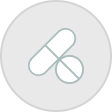Amino acids are the smallest building blocks of a protein. Proteins are "essential building blocks of life." But amino acids also fulfill independent functional roles.
A distinction is made between essential and non-essential amino acids:
- Essential amino acids: must be obtained through food - a Undersupply cannot be compensated for.
- Non-essential amino acids: can be formed in the organism using essential amino acids
Essential
- Isoleucine (VK)
- Leucine (VK)
- Lysine
- Methionine (SH)
- Phenylalanine (AAS)
- Threonine
- Tryptophan (AAS)
- Valin (VK)
Semi-essential
- Arginine
- Histidine (AAS)
- Cystine/Cysteine (SH)
- Tyrosine
Non-essential
- Alanine
- Aspartic acid/
Asparagin - Glutamine
- Asparagin
- Glutamic acid
- Glutamine
- Glycine (Glycocolla)
- Serine
- Proline
- Ornithine
- Taurine
- Hydroxyproline
- Citrulline
- 3-Methylhistidine
- L-Theanine
- Glutamine
- Glycine (Glycocolla)
- Serine
- Proline
- Ornithine
- Taurine
- Hydroxyproline
- Citrulline
- 3-Methylhistidine
- L-Theanine
- u.v.m.
Amino acids have three central functions in our body:
- Structural tasks (anabolic function), d.h. the structure of proteins (“proteinogenicity”)
- Energy production (catabolic function)
- Provision of sulfur
Proteins can be classified into the following 7 main functional groups:
| Structural proteins | Support structure of the organism | Collagen, hair, nails, |
| Contractile proteins | Components of the musculature | Myosin, actin |
| Enzymes | Catalysis of many biochemical reactions, | amylase, lipase, pepsin, trypsin, |
| Transport and | Transport of important molecules | Hemoglobin, plasma albumin, calcium-binding |
| Regulatory proteins | Control and coordination of chemical | Hormones (z.B.Insulin, oxytocin, insulin, glucagon |
| Protective proteins | Storage of substances | Blood coagulation (thrombin, fibrin, fibrinogen) |
| Control proteins | Regulation of various processes | Correctly reading the DNA |
The intake of (digestible) proteins occurs through food. By means of eEnzymatic hydrolysis releases the amino acids from the natural food proteins, which are a mixture of amino acids.
The released amino acids subsequently represent the anabolic (building, conversion in the organism into the body's own protein) and catabolic metabolism (energy, nitrogen) is available.
FREE SHIPPING
Climate-neutral, fast and free shipping within Germany from €45.
30 DAY RETURN POLICY
With us, you can quickly return unopened goods within 30 days. & Return it easily.
LABORATORY TESTED PRODUCTS
Our products are not only microbially tested by external laboratories, but also for ETO (ethylene oxide).
PRODUCED IN GERMANY
All items are produced on certified production facilities exclusively in Germany.
 based on
Reviews
based on
Reviews









